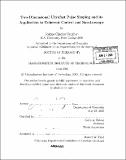Two-dimensional ultrafast pulse shaping and its application to coherent control and spectroscopy
Author(s)
Vaughan, Joshua Charles
DownloadFull printable version (10.85Mb)
Alternative title
Two-dimensional femtosecond pulse shaping and its application to coherent control and spectroscopy
Other Contributors
Massachusetts Institute of Technology. Dept. of Chemistry.
Advisor
Keith A. Nelson.
Terms of use
Metadata
Show full item recordAbstract
This thesis develops powerful new methods for shaping femtosecond laser pulses in two dimensions and explores their application to coherent control of propagating lattice excitations and degenerate four-wave mixing spectroscopy. Pulse shaping in two dimensions is achieved by manipulating the spectral components of ultrashort laser pulses within many horizontal slices of the pulse. Each horizontal slice is independently shaped by means of a two-dimensional liquid crystal spatial light modulator, and taken together the shaped regions form sophisticated optical waveforms with time-dependent spatial profiles. Automated optical control over coherent lattice responses that are both time- and position-dependent across macroscopic length scales is demonstrated. Two- dimensional (2D) femtosecond pulse shaping was used to generate excitation light fields that were directed toward distinct regions of crystalline samples, producing terahertz-frequency lattice vibrational waves that emanated outward from their multiple origins at lightlike speeds. Interferences among the waves resulted in fully specified far-field responses, including tilted, focusing, or amplified wavefronts. Generation and coherent amplification of terahertz travelling waves and terahertz phased-array generation are also demonstrated. A novel approach to coherent nonlinear optical spectroscopy based on 2D femtosecond pulse shaping is introduced. Multiple phase-stable output beams are created and overlapped at the sample in a phase-matched boxcars geometry via 2D femtosecond pulse shaping. (cont.) The pulse timing, shape, phase, and spectral content within all beams may be specified, yielding an unprecedented level of control over the interacting fields in nonlinear spectroscopic experiments. Heterodyne detection and phase cycling of the nonlinear signal is easily implemented due to the excellent phase stability between each output beam. This approach combines the waveform generation capabilities of magnetic resonance spectroscopy with the wavevector specification and phase-matching of nonlinear optical spectroscopy, yielding the signal selectivity and control capabilities of both. Results on three prototype systems will be used to illustrate the exciting possibilities with this method.
Description
Thesis (Ph. D.)--Massachusetts Institute of Technology, Dept. of Chemistry, 2005. Vita. Includes bibliographical references (p. 167-182).
Date issued
2005Department
Massachusetts Institute of Technology. Department of ChemistryPublisher
Massachusetts Institute of Technology
Keywords
Chemistry.